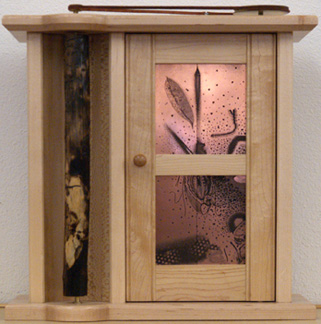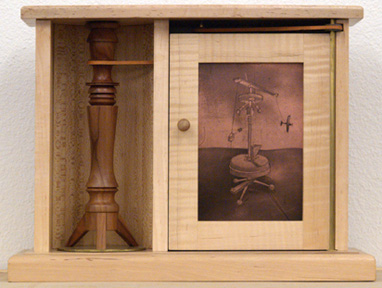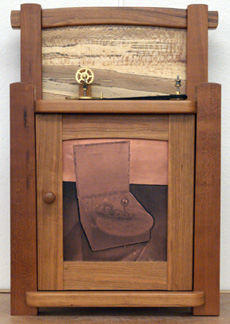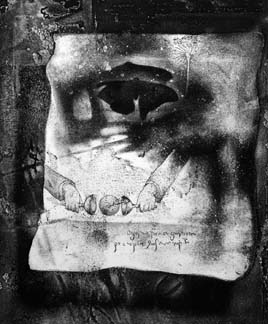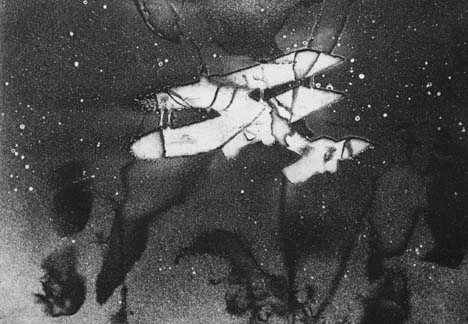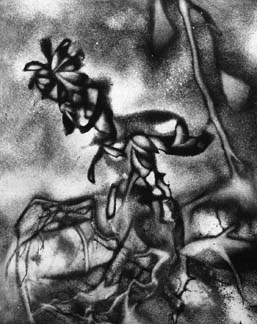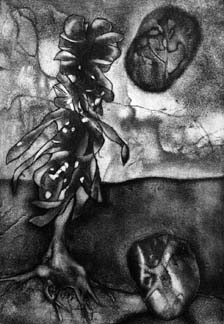Eight Etchings, Four Cabinets: Works by Tim Latourette
Tim LaTourette knows a thing or two about art, a point that is admirably demonstrated in "Thing One" and "Thing Two," two of his etchings currently on display in Mullins Library.
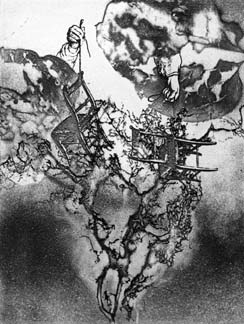
LaTourette, shop supervisor and instructor at the School of Architecture at the University of Arkansas, infuses his technical craftsmanship with a whimsical and appealing delight in simple mechanics and historic iconography.
The pieces displayed in "Eight Etchings, Four Cabinets" include just that, wood cabinetry and copperplate etchings. The cabinets are three-dimensional, actual working pieces placed on pedestals to enable viewers to admire and operate their smooth mechanisms. LaTourette says these four cabinets originated from an impulse to create "an interactive piece of furniture, one that compelled the viewer to open the door."
To that end, he uses cogs, wheels, and pulleys attached to the doors, in what he calls "simple cause and effect scenarios just tempting one to start the sequence, to put the parts into play." Opening the cabinet doors produces a movement of a focused or central piece: a turned pearwood column gently rotates in "Demiline," a tiny orb orbits fixed cogs in "Orrery," a found wood piece turns to reveal what LaTourette calls "the hieroglyphic wanderings of a beetle" marked into the wood in "Dennis's Blog."
Three cabinets also feature copperplates recycled from past printmaking projects inserted as door panels. LaTourette matches the ghostly image on the copperplate with the specific creative function of each cabinet, which, in his words, "provides a pictorial tease, clue, and suggestion of dialogue" with the mechanical action. Thus, the copperplate on "Dennis's Blog" features plant life and insect life, while the copperplate on "Orrery" reveals a mechanical assemblage of cogs and wheels very similar to the cogs that operate to revolve the tiny orb in its simple arc across a "spalled sycamore sky."
The eight etchings answer to a different muse, one of which is inspired by illustrations from an 1870 textbook entitled Elements of Natural Philosophy. LaTourette says he was "drawn by their evocative simplicity and old world graphic charm." So he created a "collaboration of sorts" with these anonymous printmakers from the past by transferring an appealing image from the book to a fresh copperplate, which he then embellished with multiple additions and layering of his own.
The result is images such as "One Tree Hill," in which a barren tree rises above a ground line under which two archaic hands grip magnetic goblets with a ball suspended between them, or "Ghost Tree," which features hands dangling chairs to illustrate gravitational centering snagged high in the branches of another barren tree.
Other prints demonstrate a "preoccupation with natural form," says LaTourette. Images such as "Thing One" and "Thing Two" are "abstracted studies based initially on actual observations" of botanical forms which are then "diverted to a more surreal interpretation."
Some items are available for purchase. For more information, contact the artist at 443-9349 or tflat@sbcglobal.net.
(Click thumbnail image to enlarge.)
